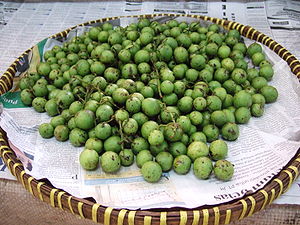Gandaria
| Gandaria | ||||||||||||
|---|---|---|---|---|---|---|---|---|---|---|---|---|

Fruits of Bouea macrophylla |
||||||||||||
| Systematics | ||||||||||||
|
||||||||||||
| Scientific name | ||||||||||||
| Bouea macrophylla | ||||||||||||
| Handle. |
Bouea macrophylla is a species of the sumac family(Anacardiaceae) and is related to the mango . It is native to Southeast Asia , the Malay Peninsula and Java, as well as Sumatra , and supplies fruit .
There are many common names in the growing areas: in Java, Philippines "Gandaria"; in Malaysia “Kundangan”, “Rembunia”, “Setar”; in Sumatra "Ramania"; in Thailand “ma-praang”, “ma-yong”; and in English “Marian plum”.
description
Appearance, bark and leaf
Bouea macrophylla grows as an evergreen tree that reaches heights of 10 to 27 meters. With a straight trunk up to 55 centimeters thick and a thick, wide treetop , its appearance is reminiscent of a mango tree . The bark is brown to gray and slightly cracked. The often drooping, angular or flattened branches are bare.
The opposite, bare leaves on the branches are 1 to 2.5 cm long with stalk. The simple, leathery, shiny and entire leaf blade is lighter on the underside. The leaves are about 14 to 30 (11 to 45) cm long and about 5 to 8 (4 to 13) cm wide, ovate to lanceolate or elliptical to oblong with a pointed to wedge-shaped blade base and a pointed to pointed upper end. The nerve is pinnate with a lighter central vein.
Inflorescence and flower
Bouea macrophylla is andromonomic with male and hermaphrodite flowers on one specimen. The flowers are in a mostly axillary, 4 to 12 cm long, paniculate inflorescence . The relatively small flowers are radial symmetry , usually four-fold and with a double flower envelope . The male flowers are stalked, the female almost sessile. The yellowish, minimal calyx lobes are egg-shaped. The yellowish to cream-colored, early brown petals are elongated to obovate, with a length of 1.5 to 2.5 mm and a width of 1 mm. Usually there is only one stamen circle with very short stamens . The unilocular ovary of hermaphrodite flowers is upper constant with short stylus and capitate, flat scar . A small pestle can be formed on the male flowers. There is a discus near the flowers .
Fruit and seeds
The bald, yellow to orange-colored stone fruit when ripe is 3 to 5 cm in diameter, almost spherical to ellipsoidal and roughly plum-shaped. With a juicy consistency and a sour to sweet taste and despite a characteristic light turpentine smell, it is suitable for raw consumption . The leathery stone core is briefly fibrous on the outside, white woolly and contains a single seed that is also edible. The cotyledons are purple in color.
Phenology
In Indonesia, the flowering period extends from June to November and the fruits ripen from March to June. In Thailand, the flowering period extends from November to December and the fruits ripen from April to May.
Occurrence
The homeland of the Gandaria are the Indonesian islands of Sumatra and western Java, as well as the Malay Peninsula . The wild occurrences are limited to tropical humid areas at altitudes of up to about 300 meters.
Because of its edible fruits, Bouea macrophylla is also grown in other tropical regions around the world at altitudes of up to around 850 meters, including Thailand .
Systematics
The first description of Bouea macrophylla was made in 1854 by William Griffith in Notulae ad Plantas ASIATICAS , 4, pp 420-423, table 567, Figure 4. synonyms are Tropidopetalum javanicum Turcz. and Bouea gandaria flower ex Miq.
use
In the tropics, the Gandaria is often planted as a fruit tree and, because of its dense crown, as a shade provider. The young leaves are also edible and can be prepared as a salad.
Cultivated forms
There are several cultivated forms in culture, here is a selection:
- 'Hintalu': The fruit of this form is very sour.
- 'Mayong Chid': The fruits are sweet and have a yellow-orange colored pulp.
- 'Ramania Pipit': Fruits with sweet red pulp.
- 'Ramania Tembaga': fruits with sweet red flesh.
swell
- Bouea macrophylla Griffith. Data sheet in the Tree Functional and Ecological Database, World Agroforestry (Section Description and Occurrence)
- Species with Potential for commercial Development at Under-utilized tropical fruits of Thailand ... der FAO. (Section Description and Names)
- Mansfeld's World Database of Agriculture and Horticultural Crops . (Names)
- OP Pareek, Suneel Sharma: Systematic Pomology. (Vol. 1-2), Scientific Publishers, 2017, ISBN 978-93-86102-81-2 (set), p. 562 f.
Web links
- Bouea macrophylla at Useful Tropical Plants.
- Description in montosogardens.com (Engl.)
Individual evidence
- ↑ Bouea macrophylla in the Germplasm Resources Information Network (GRIN), USDA , ARS , National Genetic Resources Program. National Germplasm Resources Laboratory, Beltsville, Maryland.
- ↑ Bouea macrophylla at Tropicos.org. Missouri Botanical Garden, St. Louis


